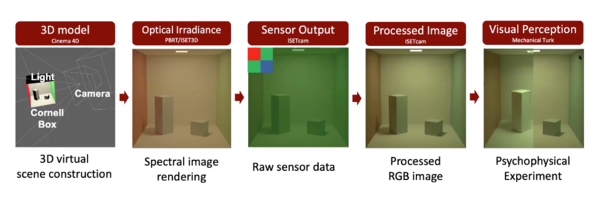WenkeZhangChien-YiChang: Difference between revisions
imported>Student221 |
imported>Student221 |
||
| Line 17: | Line 17: | ||
==== Lense Shading ==== | ==== Lense Shading ==== | ||
In this project, we | Lens shading, also known as lens vignetting, refers to the phenomenon where the light falls off towards the edges of an image when captured by digital camera systems. Lens shading occurs because in the imaging system with an optical lens, the off-axis pixels often receive a smaller bundle of incident rays compared to on-axis pixels, resulting in relatively lower illumination towards the edges. This effect is ubiquitous and not surprisingly can be observed in the data we collected for the Cornell box lighting estimation. | ||
In this project, our goal is to accurately estimate the lighting condition for the Cornell box. In order to do this, we first need to deconfound the lens shading effect from the empirical data. One way to achieve this is to preprocess the captured images to remove the lens shading effect and then compared the preprocessed images with the simulated ones. Equivalently, we can apply the artificial lens shading effect to simulated images and then compare it with real images. Here we opted for the latter method. | |||
We first assume that the lens shading effect can be represented as element-wise matrix multiplications <math>I_{LS} = I \circ M </math>, where <math>M</math> is the lens shading matrix, <math>I</math> is the simulated image, and <math>I_{LS}</math> is the simulated image with lens shading effect. We also assume that the lens shading matrix <math>M</math> is of the same dimension as the simulated image <math>I</math>, and <math>M_{ij} \in [0,1]</math>. | |||
== Results == | == Results == | ||
Revision as of 10:40, 6 December 2020
Introduction
Background
Methods
Overview

Light Modeling
Physical Based 3D Scene Rendering
Camera Modeling
Lense Shading
Lens shading, also known as lens vignetting, refers to the phenomenon where the light falls off towards the edges of an image when captured by digital camera systems. Lens shading occurs because in the imaging system with an optical lens, the off-axis pixels often receive a smaller bundle of incident rays compared to on-axis pixels, resulting in relatively lower illumination towards the edges. This effect is ubiquitous and not surprisingly can be observed in the data we collected for the Cornell box lighting estimation.
In this project, our goal is to accurately estimate the lighting condition for the Cornell box. In order to do this, we first need to deconfound the lens shading effect from the empirical data. One way to achieve this is to preprocess the captured images to remove the lens shading effect and then compared the preprocessed images with the simulated ones. Equivalently, we can apply the artificial lens shading effect to simulated images and then compare it with real images. Here we opted for the latter method.
We first assume that the lens shading effect can be represented as element-wise matrix multiplications Failed to parse (SVG (MathML can be enabled via browser plugin): Invalid response ("Math extension cannot connect to Restbase.") from server "https://wikimedia.org/api/rest_v1/":): {\displaystyle I_{LS} = I \circ M } , where is the lens shading matrix, is the simulated image, and is the simulated image with lens shading effect. We also assume that the lens shading matrix is of the same dimension as the simulated image , and .
Results
Lens Shading
TODO @chien-yi
Lighting Estimation
Real Scene
TODO @wenke add colorbar to grayscale colormap
3D Scene
TODO @wenke add model figures
Conclusions
Reference
[1] A system for generating complex physically accurate sensor images for automotive applications. Z. Liu, M. Shen, J. Zhang, S. Liu, H. Blasinski, T. Lian, and B. Wandell,Electron. Imag., vol. 2019, no. 15, pp. 53-1–53-6, Jan. 2019.
[2] A simulation tool for evaluating digital camera image quality (2004). J. E. Farrell, F. Xiao, P. Catrysse, B. Wandell . Proc. SPIE vol. 5294, p. 124-131, Image Quality and System Performance, Miyake and Rasmussen (Eds). January 2004
TODO @chien-yi



![{\displaystyle M_{ij}\in [0,1]}](https://wikimedia.org/api/rest_v1/media/math/render/svg/c171c38a164353bfdf183dee5e92150f0a66a96d)